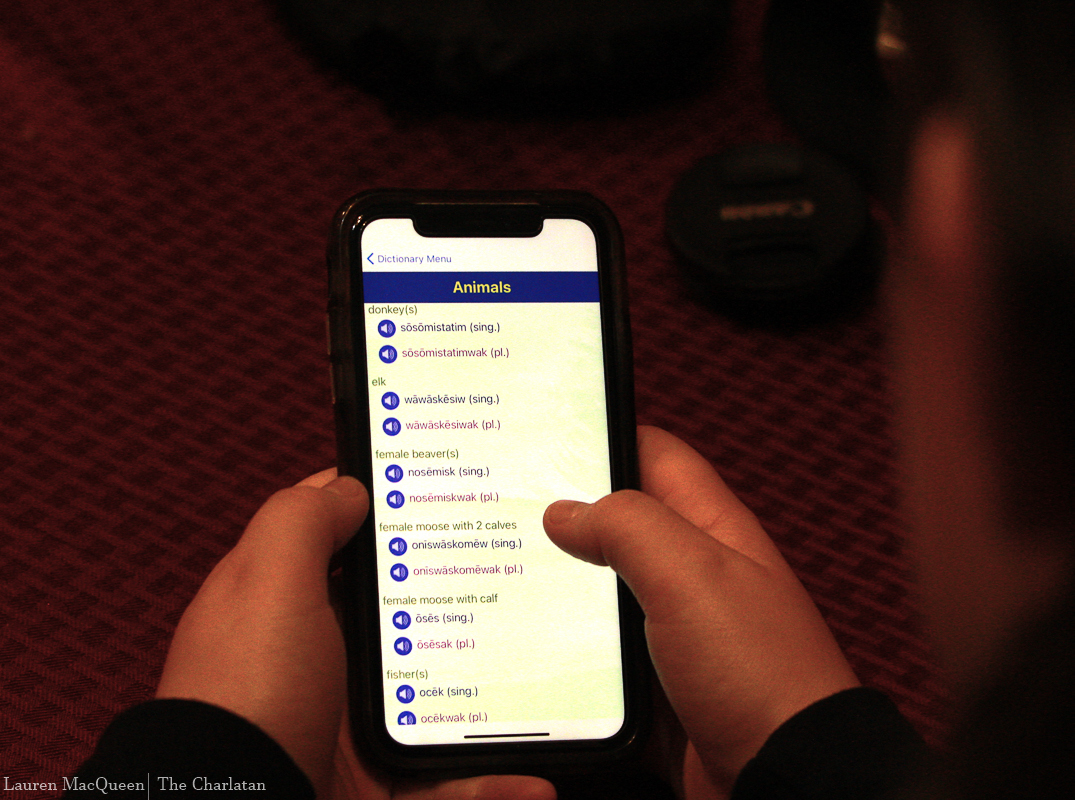
University of Winnipeg student Cameron Adams has made Swampy Cree accessible to all with the recent launch of his new language app, nēhinawēwin, with support from Elders and faculty.
The app contains a dictionary and search function that reveals hundreds of Swampy Cree words and phrases categorized by dozens of themes, from camping and fishing to banking and grocery shopping.
Users can switch the app’s text between Cree syllabics and Standard Roman Orthography, which is the Latinized writing system for Cree.
Adams, 22, and of Ojibway, Swampy Cree and French-Canadian descent, took interest in his ancestors’ language when he started learning his genealogy in Grade 6.
“Identity is a thing that people pick up in pieces … And this [language] is one piece to a puzzle that’s maybe 1,500 pieces,” Adams said.
He began teaching himself Swampy Cree, which some speakers call nēhinawēwin, as a hobby after his grandmother gifted him a Swampy Cree dictionary.
At the start of his integrated bachelor of education and bachelor of arts at U of W, Adams took introductory Cree courses and met weekly with Elder Margaret Osborne, who is also Swampy Cree and an elder-in-residence at U of W.
“He used to come to the office and try to speak Cree, and then I sort of started helping him pronounce words and stuff. I started telling stories in Cree and he would do the videotape thing,” Osborne recalled.
Starting work on the app around December 2018, Adams dedicated more than three years to the project in his spare time before doing a virtual launch on Jan. 14 over Facebook Live. Osborne assisted with the app’s vocabulary and translations.
Using a Google Sheets file, other translators typed Swampy Cree vocabulary while an editor read through the more than 70 sections.
“And they’re not extensive yet,” Adams said. “The goal is to grow [the categories of the app] to where you have lots more language in it.”
Some sections target demographics like children, while others cover topics important to Indigenous lifestyle, including fishing, hunting, trapping, animals, berries and medicine.

Cook has spoken Cree her whole life, spending decades teaching in Manitoba’s public school system and educating Cree speakers at University College of the North in The Pas, Man.
“They had lost quite a bit of the old vocabulary, like the living-off-the-land kind of vocabulary,” she said, referencing the Cree speakers she previously taught.
Cook’s son convinced her to work with Adams after seeing his requests for Cree speakers who knew Standard Roman Orthography.
“I really wanted to leave something behind for my grandchildren and great-grandchildren to learn Cree because so much of the language has been lost,” Cook said.
Adams estimated Cook spent about 200 hours on the recordings, which he said was a crucial part given the limited number of audible Swampy Cree resources for language learning.
Adams said he hoped to expand the app’s content to make learning the language independently easier.
“Making the language accessible and saying that whoever wishes to learn the language, can learn the language … I think that’s the whole goal of this app,” Adams said.
Photos, games and audible stories are among possible future additions to the app. Adams also plans to habitually add, correct and update vocabulary as if it were “vehicle maintenance.”
Osborne advocated for the app to include brand-new vocabulary for technology like phones, televisions and cars but also said it was important to add language typical of the older generations.
“I’m 70 years old and I speak fluently, so not all the words are in that app,” she pointed out.
Cook said she was sad a lot of vocabulary and audio did not make the final cut but looked forward to seeing the app in a more polished form, as well as the app being made available for Android.
“I want the language to live,” she said.
She recalled from teaching in Winnipeg’s North End the excitement in Aboriginal students whenever she taught them Indigenous language and culture.
“I’m hoping that our youth will find their way back to where their ancestors were with the culture and the language,” Cook said.
Adams intends to complete a Cree language teaching practicum, having recently submitted his fifth-year certification form. He said he anticipates the app will be handy.
“I’ll be definitely using it in the classroom as a go-to resource,” he said. “Kids can access it on iPads. It’ll be that resource at home if parents want to teach their kids Cree [and] have some audio.”
Adams said every person deserves the opportunity to learn the language of their ancestors.
“The young ones will definitely learn from [the app] and build up their language. If they’re serious enough to learn fluently, they will learn it fluently,” Osborne said.
“The language is our culture.”
Featured image provided by the University of Winnipeg.





